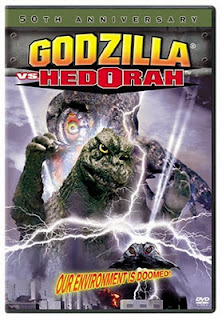Tuesday, October 25, 2011
Monsterthon: Godzilla vs. Hedorah
Let's jump ahead to something more horrific. Godzilla vs. Hedorah, once released in the US as Godzilla vs. the Smog Monster, came at a dark time for the Godzilla franchise, with the passing of Eiji Tsubaraya and the general collapse of the Japanese film industry, which had an especially harsh impact on the budgets of kaiju and other effects-driven movies. Intended to kick off a new generation of Godzilla movies, with a new director and new, more kid-friendly attitude, Godzilla vs. Hedorah ended up being a strange, surrealistic experience. It is, frankly, insane, defying any expectation of what a Godzilla movie should be and playing by a set of rules it just made up. There's never been a Godzilla film like it before or since, and the results are goofy, atmospheric, and kinda creepy.
Ships are being destroyed, fish killed off, and the sea polluted even more than it was already by a strange tadpole-like creature, dubbed Hedorah by a boy named Ken (Hiroyuki Kawase) who saw it up close and whose father, a scientist (Akira Yamauchi), was scarred by the creature while diving. A strange mineral-based lifeform who feeds on pollution while excreting acidic gas and poison sludge, Hedorah eventually wades ashore to feed on our smokestacks, attracting the attention of Godzilla, now a full-fledged hero and guardian of mankind. Fighting the monster proves difficult, though, as Hedorah is literally a walking pile of sludge with no vital organs, and Godzilla's radioactive breath has the unfortunate effect of making the smog monster stronger. Mankind races for a solution as Hedorah eventually takes to the skies, burying Japanese cities under a blanket of poisonous acidic fog.
The early seventies saw the rise of the environmentalist movement as we now know it, and Japanese genre media has always paid a lot of attention to the issue of nature being despoiled by pollution (see also most of the works of Miyazaki.) The whole "global warming" concept had yet to catch much attention, but Hedorah- whose name is derived from the Japanese word for pollution- embodies the fear of industry making Earth an unlivable mess of smog and toxic sludge. There's something neat about seeing an icon of the nuclear menace tackle a symbol of a newer threat, and it's actually a fascinating monster concept: a mineral-based lifeform that grows and changes as it feeds, and so embodying the pollution of water, land, and air all at once. Some actual thought has been put into Hedorah's nature, and it's fairly logical.
That's where the logic ends. The film's fundamental oddness starts with its score by Masaru Sato, which includes a strange blaring horn theme for Godzilla, a rousing environmental anthem, and an overall small-jazz-combo feel. There are animated sequences depicting Hedorah's growth and people in the streets wearing gas masks. Public outrage is represented by a mosaic of television screens depicting angry citizens (and, disturbingly, a crying baby half buried in sludge, increasingly marginalized at the bottom left corner as the mosaic grows). A teenage rock party at Mt. Fuji is watched by ghostly elders. We go from material clearly intended to play for the kids in the audience (various bits of physical comedy, and an astounding sequence wherein Godzilla flies) to moments of utter horror, sometimes within the same scene. The overall atmosphere is a gloomy one, but at the same time the horror is much softer than it could be. It's pop art psychedelia, but with a touch of seventies pessimism added.
The visual effects, now directed by Teruyoshi Nakano, are a mixed bag. Hedorah is impressively strange, almost Lovecraftian in its design, and there's some nice animation, but the miniature work is sparse and you can tell they don't have the resources they used to. Director Yoshimitsu Banno does give the film a very nice look, but the sheer dimness of it is wearying at times, especially in Godzilla and Hedorah's first battle.
It's hard to analyze this movie in terms of plot and characterization and linear progression towards a climax. It sort of moves in that direction, but the story is so sparse at points that it almost doesn't matter. We just sort of move into grimmer and grimmer territory as Hedorah's reign spreads, until the final battle takes place on Mt. Fuji in the blackest night. It's honestly kind of intense, despite being completely ridiculous and having something of a protracted conclusion.
Banno clearly had some big ideas, but alas it was not to be. Tomoyuki Tanaka, the Toho exec who oversaw the Godzilla series from the start, was hospitalized while this film was being made, and went ballistic when he finally saw it, accusing the director of ruining the character. Banno was banned from Toho completely, and the series went in a more traditional direction. Still, at least one completely idiosyncratic art-house adventure ended up on Godzilla's resume, and despite its flaws, Godzilla vs. Hedorah is a picture even non-fans should check out. You have to see it to believe it.
Written by Yoshimitsu Banno and Takeshi Kimura
Directed by Yoshimitsu Banno
Grade: B+
Labels:
Kaiju,
Monsterthon,
Movies
Subscribe to:
Post Comments (Atom)

No comments:
Post a Comment